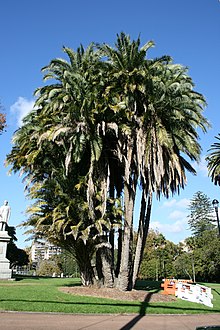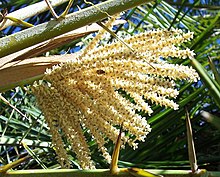
Phoenix is a genus of 14 species of palms, native to an area starting from the Canary Islands in the west, across northern and central Africa, to the extreme southeast of Europe (Crete), and continuing throughout southern Asia, from Anatolia east to southern China and Malaysia. The diverse habitats they occupy include swamps, deserts, and mangrove sea coasts. Most Phoenix species originate in semi-arid regions, but usually occur near high groundwater levels, rivers, or springs. The genus is unusual among members of subfamily Coryphoideae in having pinnate, rather than palmate leaves; tribe Caryoteae also have pinnate or bipinnate leaves.
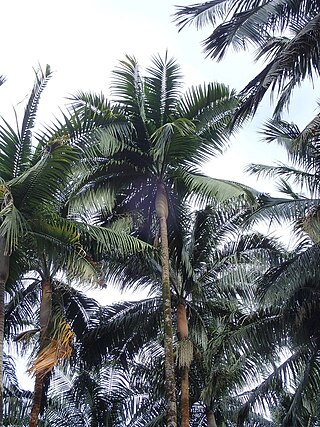
Acanthophoenix is a genus of flowering plants in the palm family from the Mascarene Islands in the Indian Ocean, where they are commonly called palmiste rouge. A genus long in flux, three species are currently recognized, though unsustainable levels of harvesting for their edible palm hearts have brought them all to near extinction in habitat. They are closely related to the Tectiphiala and Deckenia genera, differing in the shape of the staminate flower. The name combines the Greek words for "thorn" and "date palm".

Kigelia is a genus of flowering plants in the family Bignoniaceae. The genus consists of only one species, Kigelia africana, which occurs throughout tropical Africa. The so-called sausage tree grows a poisonous fruit that is up to 60 cm long, weighs about 7 kg, and resembles a sausage in a casing.

Calendula officinalis, the pot marigold, common marigold, ruddles, Mary's gold or Scotch marigold, is a flowering plant in the daisy family, Asteraceae. It is probably native to southern Europe, though its long history of cultivation makes its precise origin unknown. It is also widely naturalised farther north in Europe and elsewhere in warm temperate regions of the world.

The wildlife of Botswana refers to the flora and fauna of this country. Botswana is around 90% covered in savanna, varying from shrub savanna in the southwest in the dry areas to tree savanna consisting of trees and grass in the wetter areas. Even under the hot conditions of the Kalahari Desert, many species survive; in fact the country has more than 2500 species of plants and 650 species of trees. Vegetation and its wild fruits are also extremely important to rural populations living in the desert and are the principal source of food, fuel and medicine for many inhabitants.
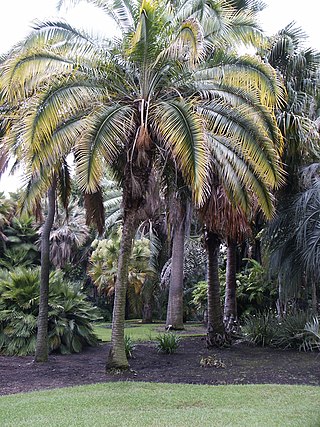
Phoenix rupicola or cliff date palm is a species of flowering plant in the palm family, native to the mountainous forests of India and Bhutan from 300 to 1200 m, usually occurring on cliffs, hillsides and similar terrain. It is threatened by habitat loss in its native range. On the other hand, the species is reportedly naturalised in the Andaman Islands, the Leeward Islands, Cuba and Puerto Rico and a specimen has recently been reported in Saint Lucia.

Roscheria is an endangered, monotypic genus of flowering plant in the palm family. The genus is named for Albrecht Roscher, a 19th-century German explorer, and the epithet for its single species R. melanochaetes derives from Latin and Greek meaning 'black' and 'bristle', alluding to the spines covering the trunks. They naturally occur on the Mahé and Silhouette Islands of Seychelles where they grow in mountainous rainforest and are threatened by habitat loss.

Phoenix loureiroi is a species of flowering plant in the palm family, indigenous to southern Asia, from the Philippines, Taiwan, India, southern Bhutan, Burma, Thailand, Cambodia, Vietnam, Pakistan, and China. It occurs in deciduous and evergreen forests and in clear terrain from sea level to 1,500 m altitude.

Phoenix pusilla, the Ceylon date palm or flour palm, is a species of flowering plant in the palm family, native to southern India and Sri Lanka. They are found in lowlands, ridges and on hills. No taller than 5 m, this species is usually single-stemmed but clumps do occur naturally. At 25 cm in diameter, the trunks are covered with distinct leaf-base scars, forming a 'wicker' pattern. Their distinguishable trunks have made them popular in cultivation. They are drought tolerant and slow-growing.

Phoenix sylvestris also known as silver date palm, Indian date, sugar date palm or wild date palm, is a species of flowering plant in the palm family native to southern Pakistan, most of India, Nepal, Bhutan, Myanmar and Bangladesh. It has been introduced to southeastern China, Sri Lanka, Mauritius, Puerto Rico and the Leeward Islands. Growing in plains and scrubland up to 1300 m above sea level, the fruit from this palm species is used to make wine and jelly. The sap is tapped and drunk fresh or fermented into toddy. The fresh sap is boiled to make palm jaggery in West Bengal state of India and Bangladesh.

Caryota urens is a species of flowering plant in the palm family, native to Sri Lanka, India, Myanmar and Malaysia, where they grow in fields and rainforest clearings, it is regarded as introduced in Cambodia. The epithet urens is Latin for "stinging" alluding to the chemicals in the fruit. Common names in English include solitary fishtail palm, kitul palm, toddy palm, wine palm, sago palm and jaggery palm. Its leaf is used as fishing rod after trimming the branches of the leaf and drying. According to Monier-Williams, it is called moha-karin in Sanskrit. It is one of the sugar palms.

Aphandra is a monotypic genus of flowering plants in the palm family native to the Amazon rainforest vegetation in South America. Its only species is Aphandra natalia, sometimes called mastodon palm or fiber palm, and is used by indigenous peoples in the construction of brooms and other products. This plant is commercially exploited for its edible fruits, and for its leaf sheath and petiole fibers. This fiber is almost equal to the fiber extracted from Attalea funifera and Leopoldinia piassaba, which is called piassava.

Ammandra is a monotypic genus of flowering plants in the palm family found in Colombia and Ecuador, where it is endangered. The sole species is Ammandra decasperma, although another species name has been proposed. It is a pinnate-leaved, dioecious palm whose seeds and petioles are used in button and basket making, respectively. It is commonly called ivory palm or cabecita.
Barcella is a monotypic genus of flowering plant in the palm family found in the States of Amazonas and Roraima in northwestern Brazil. The only known species is Barcella odora which is used by the Brazilian peoples in construction and for various thatched goods.

Brassiophoenix is a genus of monoecious flowering plants in the palm family found in Papua New Guinea. Of the two similar species, one is more common in cultivation and was mistakenly identified as Brassiophoenix schumannii. In 1999, Zona and Estig showed that the commonly cultivated species was instead the type species Brassiophoenix drymophoeoides. The two species are distinguished by their separated geographical locations and minor differences in fruit form. The genus name is a combination of the surname Brass, honoring the first collector L.J. Brass, and Phoenix, another palm genus.

Dictyosperma is a monotypic genus of flowering plant in the palm family found in the Mascarene Islands in the Indian Ocean. The sole species, Dictyosperma album, is widely cultivated in the tropics but has been farmed to near extinction in its native habitat. It is commonly called princess palm or hurricane palm, the latter owing to its ability to withstand strong winds by easily shedding leaves. It is closely related to, and resembles, palms in the genus Archontophoenix. The genus is named from two Greek words meaning "net" and "seed" and the epithet is Latin for "white", the common color of the crownshaft at the top of the trunk.

Lepidocaryum is a monotypic genus of flowering plant in the palm family from South America where the lone species, Lepidocaryum tenue, is commonly called poktamui. Nine species names have been published, but palm taxonomists currently agree that just one variable species includes them all. The most reduced member of the Lepidocaryeae, it is similar in appearance to two closely related genera, Mauritia and Mauritiella, as well as to the former genus Lytocaryum. The genus name combines the Greek words for "scale" and "nut" and the species epithet is Latin for "thin".

Mauritiella is a dioecious genus of flowering plant in the palm family found in South America where it is commonly called buriti. It is named after the similar and closely related genus Mauritia.
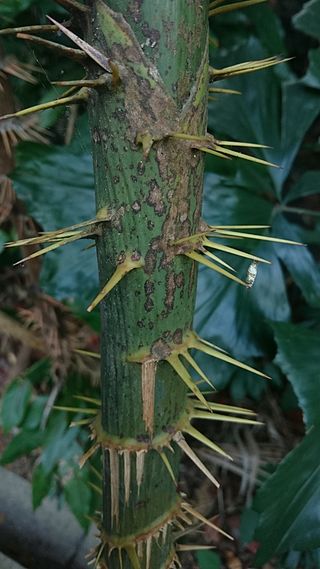
Myrialepis is a monotypic genus of flowering plant in the palm family. The single species, Myrialepis paradoxa, is native to Southeast Asia. The genus name is a combination of the Greek words meaning "innumerable" and "scale", a description of the fruit, and the epithet is Latin for "paradox".
Nenga is a monoecious genus of flowering plant in the palm family. It is native to Southeast Asia and commonly called pinang palm. The genus name is based on a corruption of a Javanese term for a plant now classified within Pinanga.
